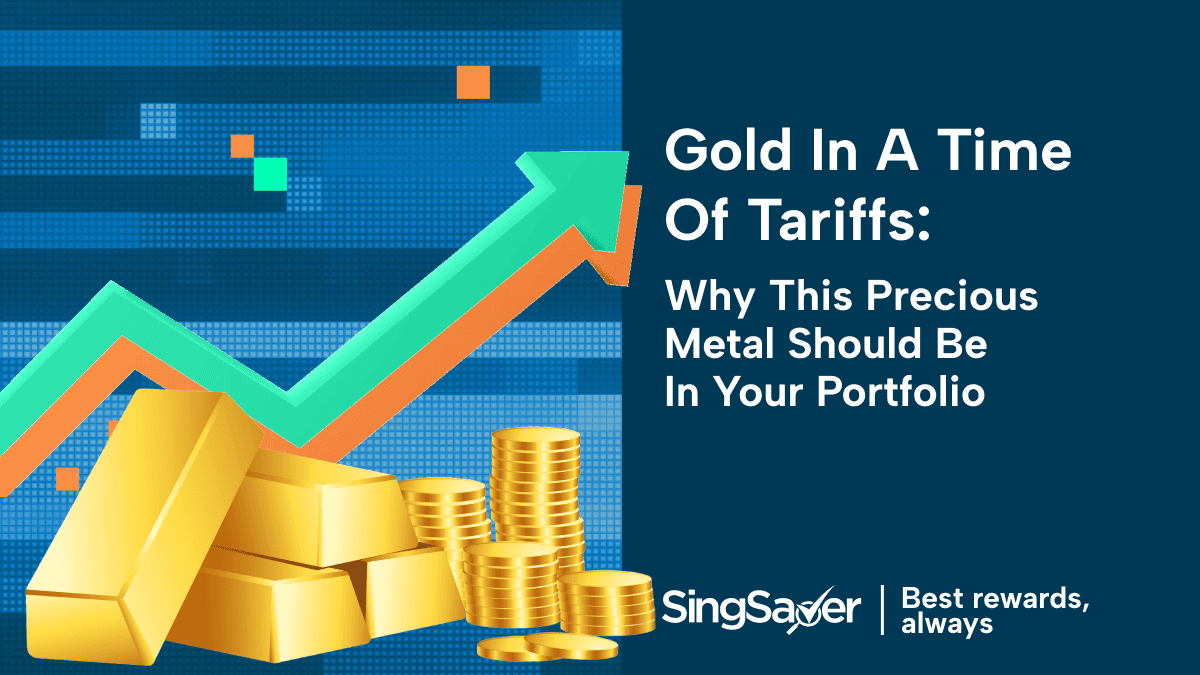Gold in a Time of Tariffs: Why this Precious Metal Should be In Your Portfolio
Updated: 22 May 2025
Gold has a proven record as a safe haven asset, and with Trump’s trade tariffs throwing the markets into chaos, the shiny metal is coming into the spotlight again. Here’s what gold could do for your portfolio.
Written bySingSaver Team
Team

Trump’s on-again-off-again trade tariff policy has turned the stock markets into roller coaster rides. After days of panic-selling driving markets around the world into free fall, Trump’s administration implemented a 90-day pause for all countries except China – enacted only 13 hours after the tariffs had gone into effect.
This, of course, had a whiplash effect on markets with the S&P 500 rocketing up by 9.52% – its biggest one-day gain since 2008. Meanwhile, the Dow Jones Industrial Average advanced by 7.8%, the index’s largest one-day gain since 2020.
However, these proved to be merely flashes in the pan, with both indices having since fallen back down, erasing previous gains and then some. The rally was wiped out by deepening fears surrounding the impact of an escalating US-China trade war.
It’s not all doom and gloom though. Whenever stock markets become chaotic, investors tend to flock to safe haven assets, increasing their demand and driving their prices up. While there are many safe haven assets, gold is probably the most well-known – and for good reason, as you’ll soon see.

What makes gold a safe haven asset?
Safe haven assets are assets that have held or even increased their value during broader market downturns. This is due to such assets being un-correlated, or even negatively correlated to macroeconomic cycles, which means their price trends tend to progress independently of whatever else that is going on in the markets.
Besides being negatively correlated to greater macroeconomic cycles, safe haven assets tend to:
Have limited supply, making them resistant to inflation or devaluation.
Enjoy a consistent level of demand that endures throughout different economic conditions.
Have permanence, which means they are not easily destroyed or replaced.
When we consider the above, we see that gold possesses all these characteristics. It is a precious metal that has only limited amounts available; it continues to be regarded as a store of value; and it offers unique properties not found in other metals, making it irreplaceable in a variety of industrial applications, including healthcare, electronics and technology.
This is why gold continues to be an enduring safe haven asset that investors pile into during times of market volatility to safeguard their holdings.
How has gold performed during the recent market chaos?
Gold has performed just as well as to be expected, given its well-known safe status.
At the time of writing, gold has soared to an all-time high, with spot prices exceeding USD 3,200 per oz. This came right on the heels of a previous high when gold broke USD 3,000 per ounce in late March.
The reason why gold is exploding off the charts is simply because of increased demand from investors. Spooked by current stock market conditions, trade war fears and continued global uncertainty, investors dump their stock holdings in favour of gold, pushing up the price of the precious metal in the process.
In addition to being a safe haven, gold has long been seen as a reliable store of value. It is traditionally sought after by those wanting to protect their wealth – and this demand only increases during times of economic turmoil such as now.
If you’re wondering if it’s too late to get into gold now, well, analysts expect that the rally still has gas left in the tank. Bank of America forecast that gold could reach USD 3,500 per ounce within the next two years, while Goldman Sachs anticipates the price will hit USD 3,300 per ounce by the end of 2025.

How to invest in gold?
There are primarily three ways to invest in gold: bullion, ETFs and futures.
Investing in gold bullion
Gold bullion refers to buying and owning gold bars and coins, which come in different weights and sizes. This is a classic buy-and-hold strategy: You can purchase gold bullion when the market is low and let your holdings appreciate over time. You can pass on your gold to descendants, or sell when the time is right for a profit.
Besides the inherent value of gold, bullion can also offer additional value for collectors pieces – these are gold coins with unique designs, such as those issued for commemorative purposes. Collectors may be willing to pay a small premium to own such pieces, but don’t expect to get rich quick.
One note though: Do not confuse gold jewellery with gold bullion. That’s because gold in its pure form is too soft to be used as jewellery. Gold jewellery pieces are instead formed from alloys, and have a lower purity grade than bullion. Thus, they tend to have lower value then gold bullion.
Investing in gold ETFs
There are several ETFs that track the price of gold, and investors can purchase shares of gold ETFs in lieu of gold bullion itself. This can be a more convenient way to invest in gold, as there’s no need to take ownership of actual gold bars or coins (even though most dealers will help you securely store your gold bullion).
Gold ETFs work just like with any other ETF or investment fund. You purchase shares of the gold ETF you want, and sell them when a profit target is reached.
Note, though, that gold ETFs come with a management fee, and it’s prudent to choose one with the lowest fee you can find.
Investing in gold futures
A gold futures contract is a binding agreement to buy or sell gold at a predetermined price on a specific future date. It is a financial derivative used to lock in the price of commodities such as gold as a means to hedge against market risks.
Unlike gold bullion and gold ETFs, gold futures are more advanced instruments. investors. Investors use gold futures to speculate on the price action of gold, and they are able to take both long and short positions, depending on their view of how the gold market will move.
In practice, gold futures are more suitable to those who wish to trade the gold markets, instead of merely investing in gold for shelter against economic uncertainty.

Should you add gold to your portfolio?
Adding gold to your portfolio can balance out a portfolio that is too heavily skewed towards equities. It can help stabilize your holdings and reduce losses, giving you some mental relief as you ride out the current market volatility.
After the madness is over, you can consider staying invested in gold to maintain a degree of diversification in your portfolio. But don’t neglect opportunities to take profit and rotate back into assets with historically higher yield.
It’s important to note that gold – like any commodity – is influenced by levels of supply and demand. This means gold can also experience short-term volatility, and it’s crucial for investors not to give in to knee-jerk reactions.
Also, while gold has proven itself a capable safe haven asset, that doesn't mean it’s completely bulletproof. Gold tends to work well in a low-interest rate environment, but while the US Federal Reserve is expected to make modest interest cuts this year, it could be forced to reverse course if tariffs push inflation too high.
This, in turn, could see favour fade from gold, with investors moving instead to income-producing bonds – which are also safe haven assets in their own right.
We know, we know. We, too, wish investing was as straightforward as “buy X, hold for Y years and get Z rich”.
Alas, its not quite that simple. But judging by the current uncertainty surrounding the market, gold could offer a glimmer of hope for investors weary of seeing their portfolios beat down.
About the author
SingSaver Team
At SingSaver, we make personal finance accessible with easy to understand personal finance reads, tools and money hacks that simplify all of life’s financial decisions for you.